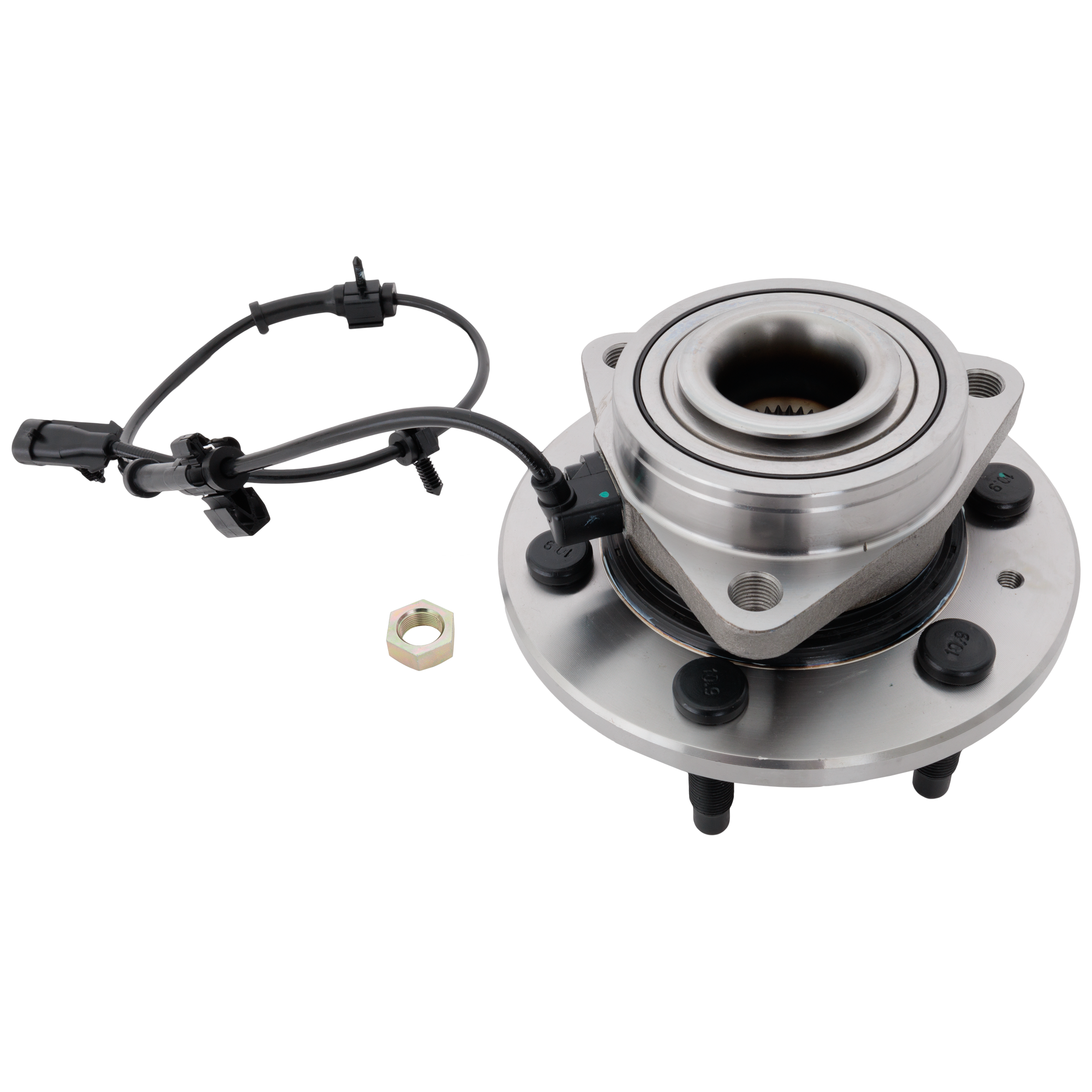A lot of other car problems can mimic a faulty wheel hub assembly. So, before you dive into any repairs, you’ll want to diagnose the problem thoroughly.
On some vehicles, the hub and bearing are two separate parts. But in this article, we’ll focus on integrated wheel hub assemblies, which house both components together in a single unit.
Wheel Hub Inspection Methods

There are several ways to inspect a wheel hub assembly. In many instances, a hub bearing will make noise without having any noticeable play. That’s why it’s important to have a variety of troubleshooting tactics at your disposal.
Note: The following is for informational purposes only. Consult the factory information for repair instructions and recommended safety procedures.
1. Inspect for play
Some faulty wheel hub assemblies, but not all, will have noticeable play when rocked by hand. Use these steps to check your car:
- Jack up the vehicle and safely support it with jack stands. Chock any wheels that remain on the ground.
- Grasp the wheel and tire assembly at the top and bottom (6 o’clock and 12 o’clock positions).
- Rock the wheel back and forth, checking for movement.
A good hub assembly should have close to zero lateral movement. If the wheel and tire assembly easily move back and forth, the hub is bad and must be replaced.


2. Check for roughness
The bearings inside the hub assembly could be worn, even if the hub doesn’t have any play. In such a situation, the bearings will become rough and cause a growling noise while the car is in motion. You can easily check for this condition. Here’s how it’s done:
- Jack up the vehicle and safely support it with jack stands. Chock any wheels that remain on the ground.
- Put the car’s transmission in neutral.
- Rotate the tire and wheel assembly by hand. It should turn smoothly.
If roughness is felt, the hub assembly may need to be replaced. To get an idea of how much “roughness” is too much, compare rotational resistance among multiple wheel/tire assemblies.
Another method is to put your hand on the suspension coil spring while rotating the wheel/tire assembly. Extreme vibration felt through the coil indicates a bad hub assembly.
3. Listen for noise

You may be able to hear a faulty hub assembly, even though you can’t feel it. Running the vehicle in the air while listening to the wheel bearing area can pinpoint the problem. Keep in mind, this only works on hub assemblies located at the drive wheels.
Note: This test should only be performed on a professional hoist. Running a car on jack stands is extremely dangerous. If the car were to pop off the stands, it could run you over.
- Raise and support the vehicle on a shop hoist.
- Have an assistant start the vehicle and run it at a moderate speed (about 40 mph).
- Place a mechanic’s stethoscope (or a long screwdriver) on the back of the steering knuckle where the hub bearing rides.
- Warning: Keep both yourself and your tool away from the rotating wheel/tire assembly to prevent personal injury.
- Listen to the wheel as it turns. All hub bearings will make a little noise while rotating, so you’ll want to compare the noise from both hub assemblies at the drive wheels.
Should one hub assembly be significantly louder than the other, the noisier of the two should be replaced.
There’s also a more sophisticated noise test that involves using an electronic stethoscope, such as the Steelman Chassis Ear. The tool has individual mics that are placed at each wheel. Driving the car while listening to the chassis ears can pinpoint a faulty hub assembly.
4. Monitor for excess heat
Although this method isn’t the most accurate, it can occasionally prove useful. The more precise (and expensive) your infrared thermometer or thermal camera is, the better your results will be.
- Drive the vehicle while listening for any possible noises from your hub bearings.
- After your test drive, park the vehicle. Then point your infrared thermometer or thermal camera at each of the wheel hub areas, one at a time.
If one wheel hub assembly is significantly hotter than the others, you may have found the bad bearing.
5. Use a dial indicator
You won’t see this method performed much in shops, but it does pop up in textbooks. This process involves a measurement tool called a dial indicator, which you can use to check the hub assembly for excessive movement. Perform the following steps to complete the test:
- Jack up the vehicle and safely support it with jack stands. Chock any wheels that remain on the ground.
- Remove the wheel and tire assembly.
- Remove the brake caliper and rotor.
- Mount the base of the dial indicator on the steering knuckle.
- Clean the portion of the hub where the dial indicator will be placed.
- Place the tip of the dial indicator on the wheel hub.
- Push the hub in and zero the dial indicator.
- Pull the hub out and note the reading on the indicator.
Generally, there should be no more than .004″ of play [1]. For an exact specification, it’s a good idea to compare the reading to the information listed in the manufacturer’s repair manual. If the measurement you got is excessive, the hub assembly should be replaced.
How to Get a Replacement Wheel Hub
A faulty wheel hub is bad news for you and other people on the road. If your wheel hub is damaged or worn, you’re likely to experience steering issues. Your wheels might stop working while driving, increasing your risk of colliding with another vehicle. For your own safety, replace your faulty wheel hub as soon as possible. Luckily, getting a new wheel hub is fast and easy with CarParts.com.
CarParts.com offers a wide selection of wheel hubs that are sourced from only the most trusted manufacturers in the industry. With the help of our vehicle selector and search filters, you can easily browse through available parts that are compatible with your ride. If you’re itching to get back on the road, you’ll be pleased to know that CarParts.com also guarantees fast shipping. Order by 12 PM ET, and you can expect your new wheel hub to arrive in as fast as two business days.
Don’t wait until your vehicle has steering issues before replacing your faulty wheel hub. Check out our catalog of high-quality wheel hubs at CarParts.com and order one today!
Shop this Project



Any information provided on this Website is for informational purposes only and is not intended to replace consultation with a professional mechanic. The accuracy and timeliness of the information may change from the time of publication.

















